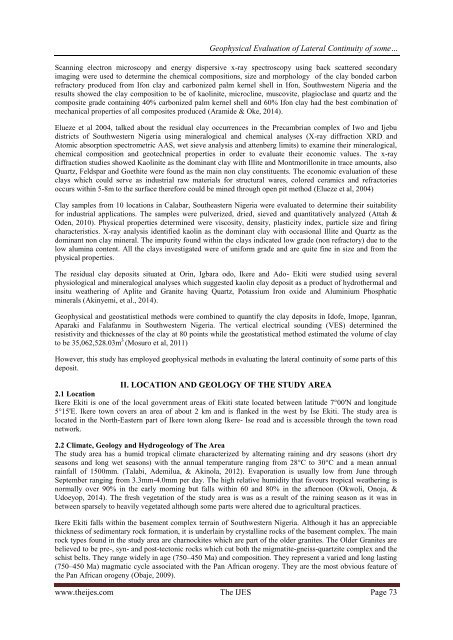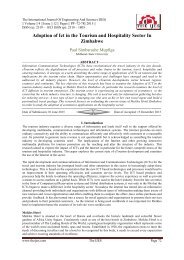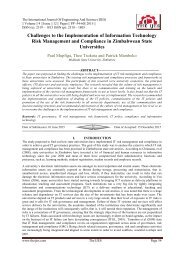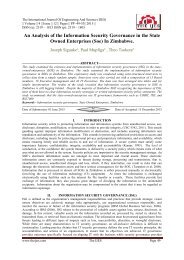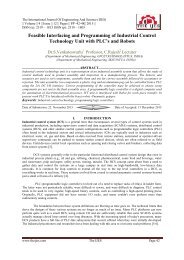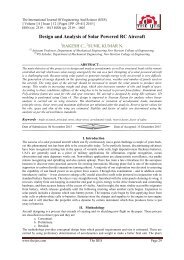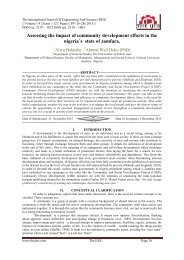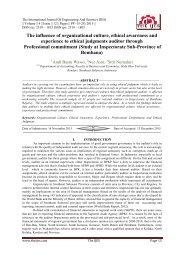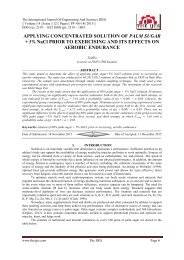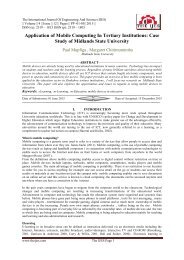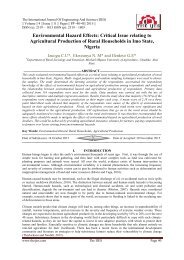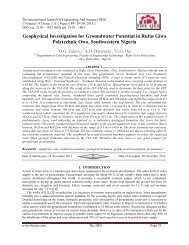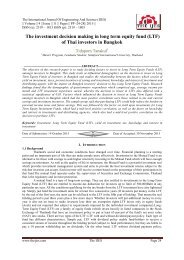Geophysical Evaluation of Lateral Continuity of some part of Ikere Kaolin Deposit, Southwestern Nigeria
The International Journal of Engineering & Science is aimed at providing a platform for researchers, engineers, scientists, or educators to publish their original research results, to exchange new ideas, to disseminate information in innovative designs, engineering experiences and technological skills. It is also the Journal's objective to promote engineering and technology education. All papers submitted to the Journal will be blind peer-reviewed. Only original articles will be published. The papers for publication in The International Journal of Engineering& Science are selected through rigorous peer reviews to ensure originality, timeliness, relevance, and readability.
The International Journal of Engineering & Science is aimed at providing a platform for researchers, engineers, scientists, or educators to publish their original research results, to exchange new ideas, to disseminate information in innovative designs, engineering experiences and technological skills. It is also the Journal's objective to promote engineering and technology education. All papers submitted to the Journal will be blind peer-reviewed. Only original articles will be published.
The papers for publication in The International Journal of Engineering& Science are selected through rigorous peer reviews to ensure originality, timeliness, relevance, and readability.
You also want an ePaper? Increase the reach of your titles
YUMPU automatically turns print PDFs into web optimized ePapers that Google loves.
<strong>Geophysical</strong> <strong>Evaluation</strong> <strong>of</strong> <strong>Lateral</strong> <strong>Continuity</strong> <strong>of</strong> <strong>some</strong>…<br />
Scanning electron microscopy and energy dispersive x-ray spectroscopy using back scattered secondary<br />
imaging were used to determine the chemical compositions, size and morphology <strong>of</strong> the clay bonded carbon<br />
refractory produced from Ifon clay and carbonized palm kernel shell in Ifon, <strong>Southwestern</strong> <strong>Nigeria</strong> and the<br />
results showed the clay composition to be <strong>of</strong> kaolinite, microcline, muscovite, plagioclase and quartz and the<br />
composite grade containing 40% carbonized palm kernel shell and 60% Ifon clay had the best combination <strong>of</strong><br />
mechanical properties <strong>of</strong> all composites produced (Aramide & Oke, 2014).<br />
Elueze et al 2004, talked about the residual clay occurrences in the Precambrian complex <strong>of</strong> Iwo and Ijebu<br />
districts <strong>of</strong> <strong>Southwestern</strong> <strong>Nigeria</strong> using mineralogical and chemical analyses (X-ray diffraction XRD and<br />
Atomic absorption spectrometric AAS, wet sieve analysis and attenberg limits) to examine their mineralogical,<br />
chemical composition and geotechnical properties in order to evaluate their economic values. The x-ray<br />
diffraction studies showed <strong>Kaolin</strong>ite as the dominant clay with Illite and Montmorillonite in trace amounts, also<br />
Quartz, Feldspar and Goethite were found as the main non clay constituents. The economic evaluation <strong>of</strong> these<br />
clays which could serve as industrial raw materials for structural wares, colored ceramics and refractories<br />
occurs within 5-8m to the surface therefore could be mined through open pit method (Elueze et al, 2004)<br />
Clay samples from 10 locations in Calabar, Southeastern <strong>Nigeria</strong> were evaluated to determine their suitability<br />
for industrial applications. The samples were pulverized, dried, sieved and quantitatively analyzed (Attah &<br />
Oden, 2010). Physical properties determined were viscosity, density, plasticity index, <strong>part</strong>icle size and firing<br />
characteristics. X-ray analysis identified kaolin as the dominant clay with occasional Illite and Quartz as the<br />
dominant non clay mineral. The impurity found within the clays indicated low grade (non refractory) due to the<br />
low alumina content. All the clays investigated were <strong>of</strong> uniform grade and are quite fine in size and from the<br />
physical properties.<br />
The residual clay deposits situated at Orin, Igbara odo, <strong>Ikere</strong> and Ado- Ekiti were studied using several<br />
physiological and mineralogical analyses which suggested kaolin clay deposit as a product <strong>of</strong> hydrothermal and<br />
insitu weathering <strong>of</strong> Aplite and Granite having Quartz, Potassium Iron oxide and Aluminium Phosphatic<br />
minerals (Akinyemi, et al., 2014).<br />
<strong>Geophysical</strong> and geostatistical methods were combined to quantify the clay deposits in Id<strong>of</strong>e, Imope, Iganran,<br />
Aparaki and Falafanmu in <strong>Southwestern</strong> <strong>Nigeria</strong>. The vertical electrical sounding (VES) determined the<br />
resistivity and thicknesses <strong>of</strong> the clay at 80 points while the geostatistical method estimated the volume <strong>of</strong> clay<br />
to be 35,062,528.03m 3 (Mosuro et al, 2011)<br />
However, this study has employed geophysical methods in evaluating the lateral continuity <strong>of</strong> <strong>some</strong> <strong>part</strong>s <strong>of</strong> this<br />
deposit.<br />
II. LOCATION AND GEOLOGY OF THE STUDY AREA<br />
2.1 Location<br />
<strong>Ikere</strong> Ekiti is one <strong>of</strong> the local government areas <strong>of</strong> Ekiti state located between latitude 7°00'N and longitude<br />
5°15'E. <strong>Ikere</strong> town covers an area <strong>of</strong> about 2 km and is flanked in the west by Ise Ekiti. The study area is<br />
located in the North-Eastern <strong>part</strong> <strong>of</strong> <strong>Ikere</strong> town along <strong>Ikere</strong>- Ise road and is accessible through the town road<br />
network.<br />
2.2 Climate, Geology and Hydrogeology <strong>of</strong> The Area<br />
The study area has a humid tropical climate characterized by alternating raining and dry seasons (short dry<br />
seasons and long wet seasons) with the annual temperature ranging from 28°C to 30°C and a mean annual<br />
rainfall <strong>of</strong> 1500mm. (Talabi, Ademilua, & Akinola, 2012). Evaporation is usually low from June through<br />
September ranging from 3.3mm-4.0mm per day. The high relative humidity that favours tropical weathering is<br />
normally over 90% in the early morning but falls within 60 and 80% in the afternoon (Okwoli, Onoja, &<br />
Udoeyop, 2014). The fresh vegetation <strong>of</strong> the study area is was as a result <strong>of</strong> the raining season as it was in<br />
between sparsely to heavily vegetated although <strong>some</strong> <strong>part</strong>s were altered due to agricultural practices.<br />
<strong>Ikere</strong> Ekiti falls within the basement complex terrain <strong>of</strong> <strong>Southwestern</strong> <strong>Nigeria</strong>. Although it has an appreciable<br />
thickness <strong>of</strong> sedimentary rock formation, it is underlain by crystalline rocks <strong>of</strong> the basement complex. The main<br />
rock types found in the study area are charnockites which are <strong>part</strong> <strong>of</strong> the older granites. The Older Granites are<br />
believed to be pre-, syn- and post-tectonic rocks which cut both the migmatite-gneiss-quartzite complex and the<br />
schist belts. They range widely in age (750–450 Ma) and composition. They represent a varied and long lasting<br />
(750–450 Ma) magmatic cycle associated with the Pan African orogeny. They are the most obvious feature <strong>of</strong><br />
the Pan African orogeny (Obaje, 2009).<br />
www.theijes.com The IJES Page 73


